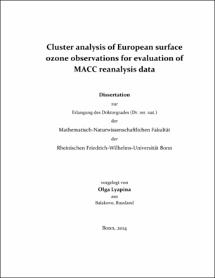Cluster analysis of European surface ozone observations for evaluation of MACC reanalysis data

Cluster analysis of European surface ozone observations for evaluation of MACC reanalysis data

| dc.contributor.advisor | Schultz, Martin G. | |
| dc.contributor.author | Lyapina, Olga | |
| dc.date.accessioned | 2020-04-20T21:55:05Z | |
| dc.date.available | 2020-04-20T21:55:05Z | |
| dc.date.issued | 22.04.2015 | |
| dc.identifier.uri | https://hdl.handle.net/20.500.11811/6451 | |
| dc.description.abstract | The high density of European surface ozone monitoring sites offers good opportunities for investigation of the regional ozone representativeness and for evaluation of chemistry climate models. In this thesis we analyze both aspects with close relation of one to another. As starting point we analyze ozone trends and the seasonal behavior of ozone concentrations at selected individual stations in different regions of Europe. At this step we are interested to find out how the observed long-term trends in surface ozone concentrations are consistent across stations, and would the annual ozone behaviour give any distinctive patterns within Europe. The next analysis is extended to seasonal-diurnal ozone variations, which appear as the main components of ozone time series and therefore allow to describe the ozone behavior more comprehensively. The regional representativeness of European ozone measurements is investigated through a cluster analysis (CA) of ozone air quality data from 1492 European surface monitoring stations (Airbase database). K-means clustering is implemented for 3 sets of properties: (i) seasonal-diurnal variations in absolute mixing ratio units, (ii) normalized seasonal-diurnal variations, and (iii) averaged and normalized seasonal and diurnal variations. Each CA identifies different ozone pollution regimes, and each of them is compared with the output of the multi-year global reanalysis produced within the Monitoring of Atmospheric Composition and Climate (MACC) project. Recent methods for evaluation of global chemistry-climate models often provide only the comparison of the simulated output mean to individual ozone observations or arbitrarily aggregated sets of observations. This can give general information about the model biases for area, captured by sites, but does not help in the interpretation of these biases. Our CA approach yields useful information for the evaluation of numerical models, as it allows for a pre-selection of stations and uses clusters as means to stratify the comparison with the respective model output. Comparing the MACC data to cluster results allows to see whether the model is able to capture specifics of each group and how well it describes the various ozone pollution regimes. The selected parameters for the investigation of ozone representativeness provide several possibilities to distinguish representative groups of ozone over Europe. Relying on the most stable conditions, there are 5 and 4 clusters which adequately describe the seasonal-diurnal ozone European patterns in case of absolute and normalized properties, respectively. Comparison of the model with observations for individual clusters reveal first of all different overestimation biases, and secondly differences mainly in seasonal ozone behavior. These biases are mostly driven by summertime ozone rather than wintertime, where ozone is generally well predicted. Such biases decrease from more polluted clusters to cleaner ones. Also the seasonal and diurnal cycles are described better for clusters with relatively clean signatures. The best fit is observed for clusters, which stations are influenced more by regional rather than local factors. While MACC is generally able to capture observed features of diurnal cycles (minima at 6 am and maxima between noon and 3pm), it fails in the description of different seasonal patterns, like spring maximum or July peak, as it always shows broad symmetrical bell-shaped summer maxima. This thesis shows the usefulness of k-means clustering as an objective classification method for surface ozone measurements stations. Using clusters to preselect observational data for comparison with global models can broaden the observational data that are available for such comparisons and help to make model evaluation more objective. | |
| dc.language.iso | eng | |
| dc.rights | In Copyright | |
| dc.rights.uri | http://rightsstatements.org/vocab/InC/1.0/ | |
| dc.subject.ddc | 500 Naturwissenschaften | |
| dc.subject.ddc | 540 Chemie | |
| dc.subject.ddc | 550 Geowissenschaften | |
| dc.title | Cluster analysis of European surface ozone observations for evaluation of MACC reanalysis data | |
| dc.type | Dissertation oder Habilitation | |
| dc.publisher.name | Universitäts- und Landesbibliothek Bonn | |
| dc.publisher.location | Bonn | |
| dc.rights.accessRights | openAccess | |
| dc.identifier.urn | https://nbn-resolving.org/urn:nbn:de:hbz:5n-39869 | |
| ulbbn.pubtype | Erstveröffentlichung | |
| ulbbnediss.affiliation.name | Rheinische Friedrich-Wilhelms-Universität Bonn | |
| ulbbnediss.affiliation.location | Bonn | |
| ulbbnediss.thesis.level | Dissertation | |
| ulbbnediss.dissID | 3986 | |
| ulbbnediss.date.accepted | 12.11.2014 | |
| ulbbnediss.fakultaet | Mathematisch-Naturwissenschaftliche Fakultät | |
| dc.contributor.coReferee | Hense, Andreas |
Dateien zu dieser Ressource
Das Dokument erscheint in:
-
E-Dissertationen (4077)




